Craft an Elite Brand Identity: A Branding Strategy Framework Guide
In a marketplace brimming with competition, a robust branding strategy framework is integral to establishing a memorable brand identity. This article delves into a strategic blueprint for building and sustaining your brand, with insights on leveraging core values, engaging target audiences, and standing out. Step by step, we’ll walk you through a framework that merges your business’s heart and strategy, setting you on a path to resonant branding that speaks to today’s consumers.
Key Takeaways
- A brand strategy framework includes defining core values, crafting mission and vision statements, and positioning your brand uniquely in the market, forming the basis for harmonious growth, differentiation, and customer loyalty.
- Identifying and understanding your target audience is crucial for tailored, resonant brand communication and positioning, supported by customer insights, user personas, and a compelling unique selling proposition (USP).
- Developing a strong, consistent visual identity and a strategic brand communication plan is essential, ensuring a cohesive, adaptable branding approach that aligns with business goals and evolves with the market to build lasting equity and success.
Decoding the Brand Strategy Framework
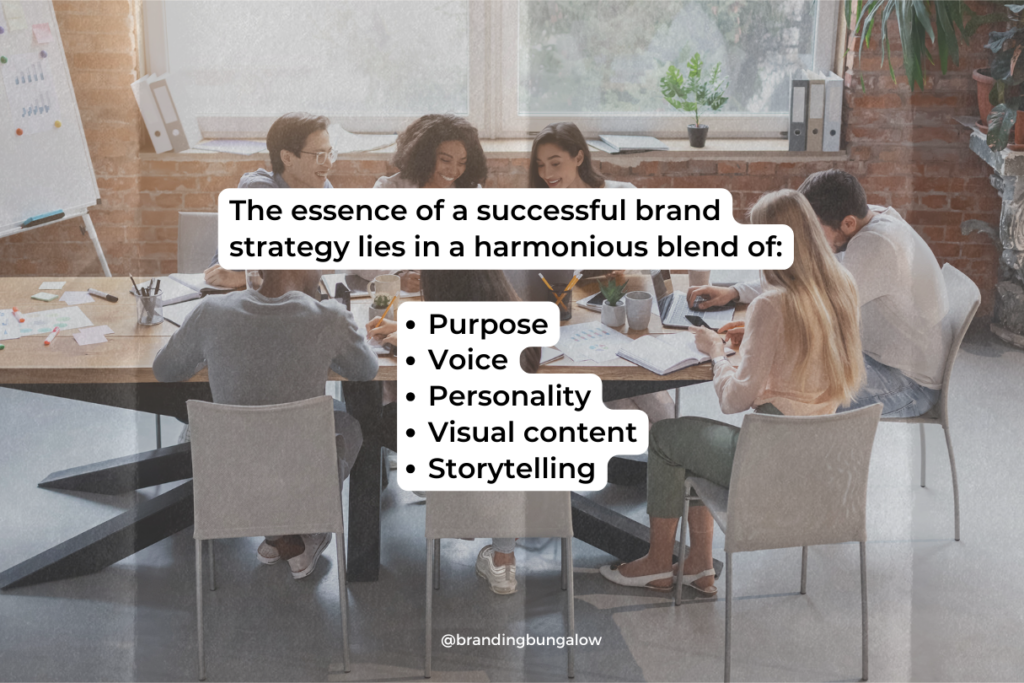
The brand strategy framework is not just a buzzword; it’s the lifeline of your brand’s identity. Envision it as a master plan that orchestrates every aspect of your business, from internal operations to brand marketing and how you engage with the world. A brand strategy serves as a lighthouse, guiding ships through foggy seas, ensuring consistency across all facets of your organization—executive and internal communications, PR, and social media strategies. At its core, strategic brand management revolves around three pillars: a brand persona that humanizes your brand, a visual identity that aesthetically represents it, and engagement practices that connect you with your audience.
The development of a brand strategy is a collaborative art form. It’s a symphony played by an orchestra of stakeholders. Each stakeholder brings ideas and insights to the table that define what sets the brand apart. This strategy is the linchpin for long-term growth. It shapes customer perceptions, driving recognition, and establishing a differentiated presence in the market.
The essence of a successful brand strategy lies in a harmonious blend of:
- Purpose
- Voice
- Personality
- Visual content
- Storytelling
These are key components for guarding your brand’s reputation.
Defining Your Brand’s Core Values
At the heart of every authentic brand, you’ll find a set of core values—fundamental beliefs that serve as the compass for all its actions. These values are the silent ambassadors of your brand. They reflect its essence and draw in a community of customers who share the same ethos. But what makes up the core of a brand? It’s a trifecta of brand purpose, vision, and values.
When you define your brand’s core values, you’re not just stating what you believe in. You’re also laying out a promise to your customers—a promise of what they can consistently expect from your brand. These values guide decision-making, inform your brand personality, and ultimately, become the magnetic force that attracts customer loyalty and advocacy. It’s about owning your brand’s narrative and ensuring every message, campaign, and interaction reinforces these foundational truths.
Establishing Your Brand Mission and Vision Statements

Your mission and vision statements are the stars by which you navigate the vast business universe. A compelling vision statement is your brand’s North Star, providing focus and a clear trajectory towards your long-term aspirations. It weaves together your brand’s mission with ambitious goals for the future, giving everyone—employees and customers alike—a glimpse into what drives your brand forward.
Crafting an effective vision statement is like painting a masterpiece. It needs to capture the essence of your company’s identity, answering the Who, What, How, Where, and Why in a manner that inspires and invites others to join your journey. The best vision statements are those that ignite a spark within. They stir up emotions and inspire people to become part of something greater than themselves.
The Art of Positioning Your Brand in a Saturated Market
In the gladiator arena of the business world, where countless brands vie for the spotlight, how can your brand not only survive but thrive? The answer lies in masterful brand positioning. Take a leaf from the success stories of disruptive brands like Airbnb, Trader Joe’s, and Dollar Shave Club. They have all etched unique positions in the market by offering distinct experiences and products that resonate with their audiences.
But positioning your brand isn’t about haphazardly throwing darts on a board and hoping one sticks; it’s a deliberate strategy. It starts with comprehensive competitor research, peeling back the layers to reveal opportunities for differentiation. You need a Unique Selling Proposition (USP) that articulates your brand’s raison d’être and captures its distinct market space.
And in the ever-evolving landscape of consumer preferences and market conditions, your brand positioning strategy must be both robust and adaptable. This ensures that your brand’s voice remains unique and relevant.
Target Audience: The Heart of Your Branding Efforts
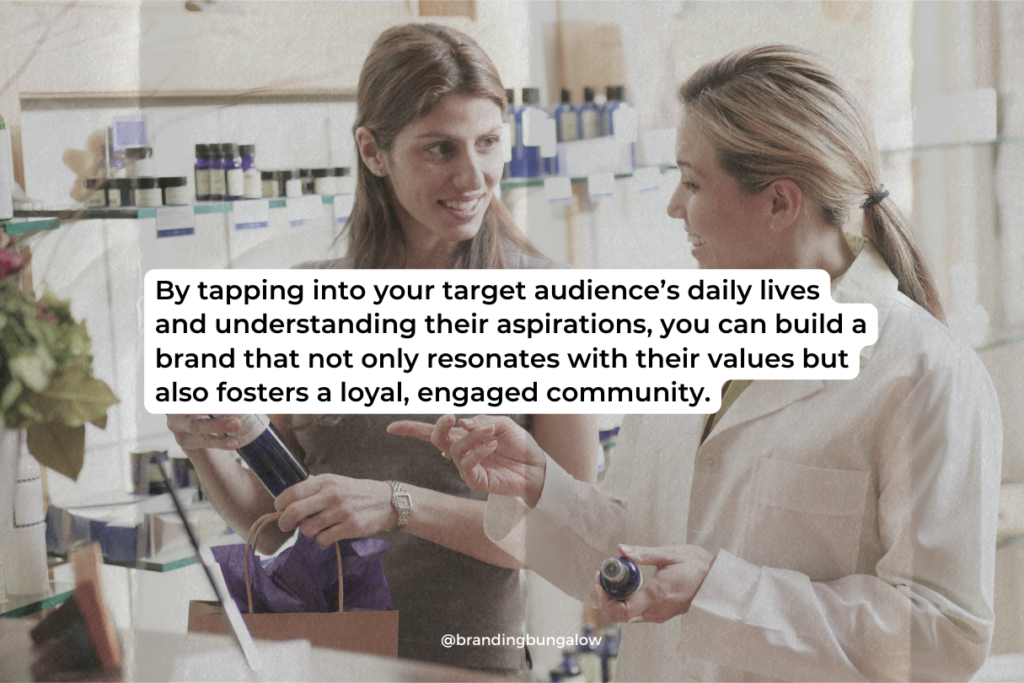
If your brand is a solar system, the target audience is the sun—everything revolves around it. Knowing your audience is the cornerstone of brand strategy. It helps align every facet of your branding efforts with the overarching business goals. It’s about crafting messages that resonate with their values, speak to their preferences, and ultimately, make an indelible impact.
When you zero in on your exact target audience, you sharpen your brand communication to a laser focus, cutting through the noise and making every word count. It’s about deepening the brand experience through detailed personas that reflect your audience’s lifestyle, goals, and behaviors. By tapping into their daily lives and understanding their aspirations, you can build a brand that not only resonates with their values but also fosters a loyal, engaged community.
And in today’s digital age, a social-first brand strategy is a golden ticket to increasing market share and deepening customer connections.
Uncovering Customer Insights through Market Research
The treasure trove of customer insights lies beneath the surface, waiting to be unearthed through diligent market research. It’s about keeping a pulse on your brand health and customer perceptions, not just at a single point in time, but continuously, adapting as the market ebbs and flows. Understanding how consumers think about brands and make purchase decisions is crucial for crafting a brand strategy that sticks.
Measuring brand equity is like taking the brand’s vital signs. It tells you if the brand is healthy or if it needs a strategy revamp. By integrating modern brand tracking methods into your market research, you delve deeper into what customers truly value. Doing so gives you the insights needed to refine your brand positioning and messaging.
Creating User Personas for Precision Marketing
Imagine being able to peek into the lives of your customers, understanding their every like, dislike, need, and desire. That’s the power of user personas. These fictional yet data-driven avatars are built using a mosaic of demographic and psychographic data. They provide a detailed sketch of your most profitable customer segments.
With user personas as your guide, you can channel your marketing efforts and resources into campaigns that resonate with precision. It’s not just about targeting a demographic. It’s about speaking directly to the heart of your audience, creating tailored experiences that turn prospects into loyal customers. And as you more effectively allocate your marketing dollars, you’re not just hitting targets—you’re building relationships.
Crafting Your Unique Selling Proposition
The market is a jungle, and your unique selling proposition (USP) is the roar that makes the crowd take notice. It’s the declaration of what makes your brand the only solution to your customers’ needs, setting you apart in a sea of competitors. A powerful USP is succinct and potent. It clearly communicates how your product or service solves problems or fulfills desires in a way that no one else can.
But it’s not just about having a catchy phrase; it’s about the promise behind it. Your value proposition must:
- Be simple, honest, and resonate at first glance
- Foster immediate understanding and trust among your customers
- Require constant testing and refining to ensure it continues to connect with your audience in the most impactful way
Communicating Value: Beyond a Catchy Logo
A catchy logo might catch the eye, but it’s the substance behind it that captures the heart. Your brand’s value proposition is a story that unfolds across every touchpoint with your customers, from the headline that grabs their attention to the finer details that keep them coming back for more. It’s about understanding the segments of your audience that are most loyal and committed. These segments are the ones most likely to advocate for your brand and notice shifts in your messaging.
Customer success stories are your brand’s badges of honor, serving as social proof that your value proposition isn’t just a hollow promise—it’s a reality for those who engage with your brand. Effective brand communication is an art form. It should express your brand’s identity, value, experience, and impact through a common language that resonates with your audience, both inside and outside your organization.
Leveraging Your USP in Marketing Campaigns
Your USP is your secret weapon, and your marketing campaigns are the battlefield where it shines. By conducting a thorough competitor analysis, you shape a USP that not only identifies the gaps in the market but fills them with your brand’s unique value. Consistency is your ally here. Brand guidelines ensure that every piece of marketing material, from a tweet to a billboard, reflects your USP and reinforces brand recognition.
Adaptation is key to survival in the wilds of the marketplace. Your brand must be agile enough to stand out, retain customer loyalty, and seamlessly weave the USP into every facet of your marketing strategy. By doing so, you’re not just making a statement; you’re creating a legacy.
Strategic Brand Communication: Speaking with One Voice
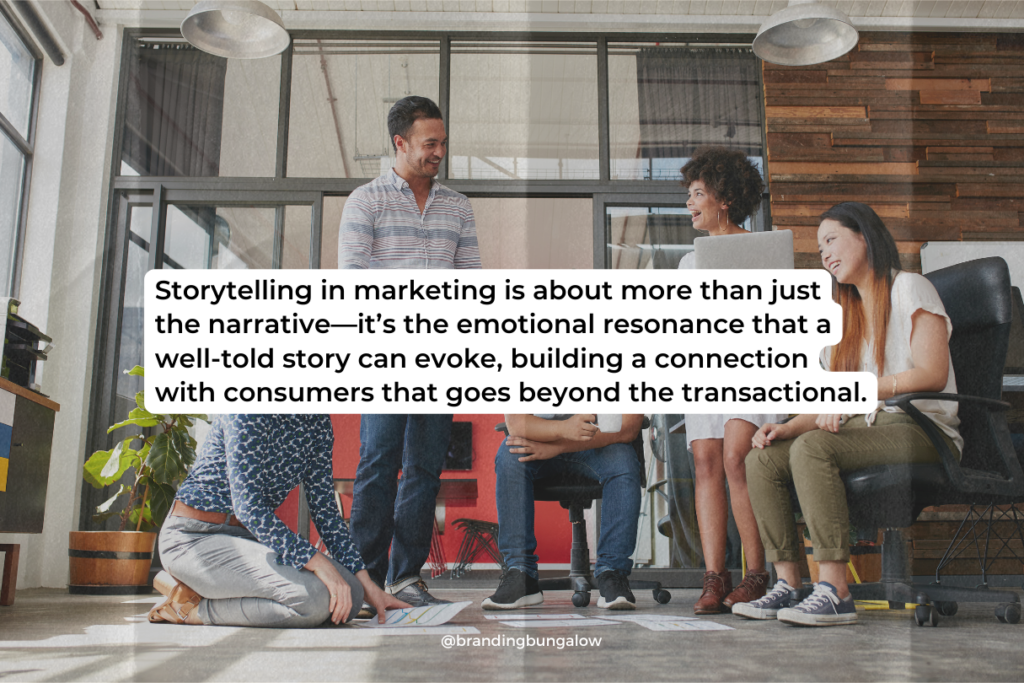
In the symphony of the market, strategic brand communication is how you ensure your brand’s voice rises above the rest, harmonious and clear. It’s about sending a message that is consistent across all channels, from social media to customer service. Establishing a distinct identity should speak directly to the heart of your customers. A well-crafted brand communication strategy doesn’t just boost recognition. It cultivates trust, credibility, and long-term customer engagement, paving the way for business growth.
This multi-layered communication strategy reaches out to audiences through varied channels, resonating with each note. Brand guidelines act as the sheet music. They ensure every team member plays the right tune, maintaining a consistent visual identity that builds brand recognition and trust. Without these guidelines, your brand may become a cacophony of mixed messages, leading to confusion and eroding customer trust.
The Role of Brand Voice in Consumer Connection
The voice of your brand is like a warm conversation with a good friend. It’s familiar, aligned with your brand’s personality, and resonates with your audience. Crafting this tone of voice goes beyond marketing copy. It encompasses communication and behavior guidelines that embody the essence of your brand.
Knowing your audience, their desires, and behaviors is the key to creating a brand story and voice that not only resonates but also forges deep connections. Authentic brand communication requires a balance of honesty, respect, and a relentless focus on providing value beyond the product or service itself.
And in a world where consumer perceptions and expectations are constantly shifting, your brand’s voice must remain both consistent and adaptable.
Storytelling: Weaving Your Brand Story into Every Interaction
Storytelling is the thread that weaves through the fabric of your brand communication. It binds your audience to your brand with emotional and memorable experiences. It’s about more than just the narrative. It’s the emotional resonance that a well-told story can evoke, building a connection with consumers that goes beyond the transactional.
Your brand’s origin story, employee anecdotes, and customer success tales are chapters in your brand’s epic. They humanize your brand, build trust, and encourage advocacy, supporting the overall brand strategy and reinforcing your brand’s message across every platform. The brand voice sets the tone for this story, ensuring it’s delivered in a style that’s unmistakably yours.
Visual Identity: The Face of Your Brand
A compelling visual identity is the face your brand presents to the world, encapsulating its essence and ensuring instant recognition. Think of it as your brand’s digital design—a reflection of quality and a significant contributor to the overall perception of your brand identity. A comprehensive visual identity system includes:
- Logo
- Typography
- Colors
- Imagery
- Other forms of visual communication
These elements collectively represent your brand’s identity with consistency and coherence.
Simplicity and memorability are the hallmarks of effective logos. These characteristics make your brand instantly recognizable and adaptable across a range of applications. And in an era where digital experiences are front and center, ensuring that your brand’s digital design is responsive and optimized for various devices is crucial for maintaining a uniform brand experience.
Consistency is Key: Developing Brand Guidelines
Brand guidelines are the rulebook that ensures your brand’s visual identity is presented consistently, no matter where it appears. These guidelines spell out the hows and whys of your:
- logo
- typography
- colors
- other graphic elements
They provide a clear blueprint for your brand’s visual presentation.
Each element of your visual guidelines—from the story behind the logo’s design to the typography system and color palette—plays a critical role in communicating your brand’s identity. Application examples, such as social media posts, demonstrate how these elements work together to convey a consistent message that resonates with your audience.
From Logos to Layouts: Elements of a Strong Visual Identity
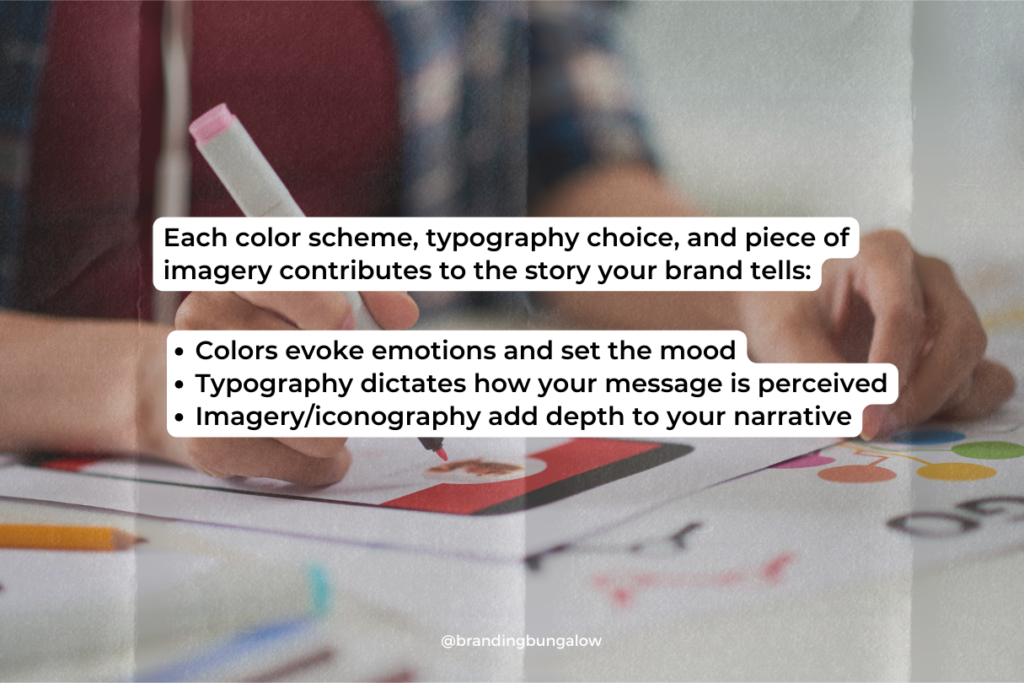
Visual identity is the visual cornerstone of your brand’s positioning, encompassing key elements such as:
- Logos
- Colors
- Typography
- Imagery
- Iconography
These components work in concert to ensure your brand is not only recognized but also felt at an emotional level. The logo, in particular, is pivotal. It’s the flag your brand waves in the face of competition and the symbol customers come to trust.
Each color scheme, typography choice, and piece of imagery contributes to the story your brand tells. Here’s how each element plays a role:
- Colors evoke emotions and set the mood
- Typography dictates how your message is perceived
- Imagery and iconography add depth to the narrative of your brand
Together, these elements form the visual language that communicates your brand’s unique story to the world.
Brand Development Strategy: Evolving with Purpose
In the ever-evolving landscape of business, a static brand is a fading brand. Your brand development strategy must be a living, breathing entity that grows with purpose. It should keep pace with market trends, technological advancements, and the ebb and flow of customer behavior. It’s not just about riding the waves of change. It’s about steering the ship with intention, ensuring your brand remains relevant and impactful.
A brand that knows itself yet adapts with agility is a brand that endures. While the market’s dynamism calls for innovation and evolution, the brand’s core identity—its mission, vision, and values—must remain steadfast, serving as the unshakeable foundation that customers trust and rely on. Repositioning may be necessary, but it must always be done in a way that aligns with the brand’s essence and the unique value it offers to its customers.
Analyzing the Competitive Landscape for Continuous Improvement
The competitive landscape is a treasure map. Analyzing it is key to uncovering the hidden gems that will set your brand apart. This ongoing process lets you peek behind the curtains of your competitors, refining your business strategies and identifying your authentic niche in the market. Comprehensive analysis includes not just direct competitors but also those on the periphery—indirect, perceived, and aspirational rivals that can offer unexpected insights.
By dissecting key market attributes—price, quality, customer reviews—you can discern where your brand stands relative to others and understand your unique offerings. This research not only reveals market gaps ripe for exploitation but also empowers you to refine your positioning strategy, ensuring your brand remains distinctive and desirable.
Measuring Success: Tracking Brand Equity and Performance
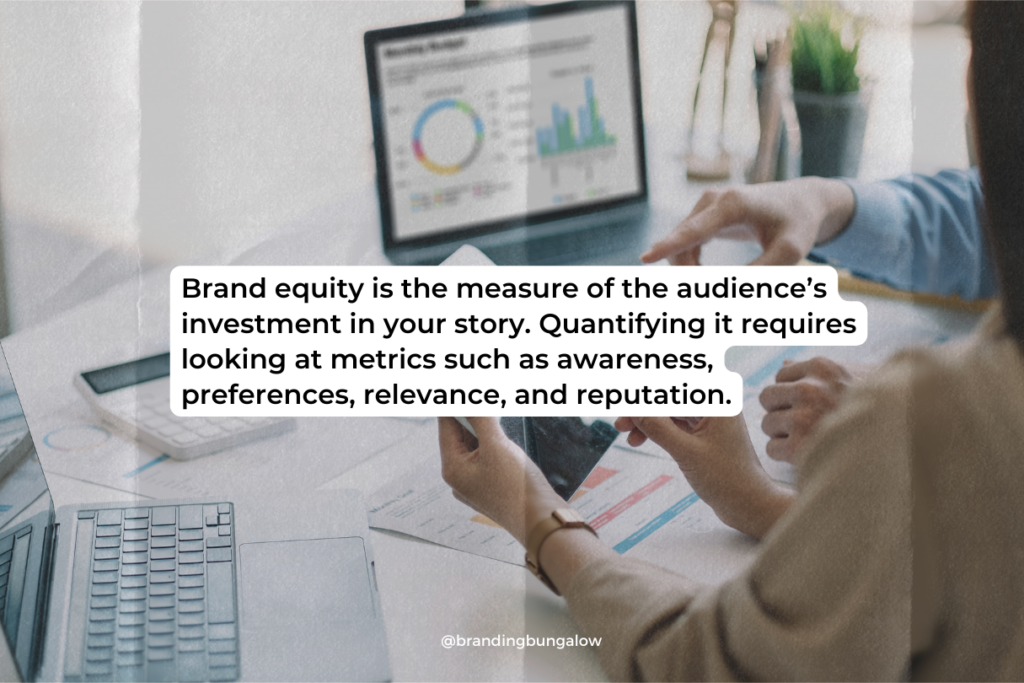
In the grand narrative of your brand, brand equity is the measure of the audience’s investment in your story. It reflects the brand’s perceived value by consumers, both financially and emotionally. Quantifying brand equity requires looking at metrics such as:
- awareness
- preference
- relevance
- reputation
Each of these metrics is a chapter in the story of how your brand is viewed by the world.
Engagement is the dance between your brand and its customers. Tracking it is vital for assessing the strength and depth of your brand’s equity. It’s about evaluating the impact of your branding initiatives and revising strategies based on performance indicators that align with your business aims. Brand awareness, relevance, and image are the cornerstones of a brand’s equity. They are the touchpoints by which you measure success and guide future evolution.
Implementing Your Branding Strategy Framework
Implementing a brand strategy framework is akin to conducting a grand orchestra. Every section and instrument must come in at the right time, playing their part in perfect harmony to create a symphony of success. It’s about aligning each stage of the framework with the rhythm of your business strategy, ensuring that every note strikes a chord with your target audience and amplifies customer acquisition and satisfaction.
At the crescendo of the branding strategy framework lies the development of a brand persona. This persona includes the personality, voice, and tagline of your brand, embodying the essence of your strategy and ensuring it resonates with your audience. It’s the final note in the symphony, the one that lingers long after the performance is over, leaving a lasting impression on your customers.
The Integration of Brand Strategy with Business Goals
Integrating brand strategy with business goals is not just about alignment; it’s about fusion. Your brand’s purpose, vision, mission, and values should not only support its identity but should also propel your business objectives forward, ensuring development and projection of a cohesive brand personality. Workshops and interviews are the crucibles where this integration is forged, clarifying the brand’s place in the market and its reason for existence.
Choosing the right channels to communicate your brand message is critical. It requires insight into both business goals and audience preferences to ensure effective reach and engagement. Consistency across all touchpoints, guided by clear usage guidelines for brand elements, safeguards your brand’s integrity and supports effective brand messaging.
Flexibility within your brand strategy allows for adaptation to changing business objectives and market conditions, ensuring that your brand remains dynamic and responsive to the evolving landscape.
From Planning to Execution: The Branding Process Timeline
The branding process timeline is a carefully charted journey from the spark of an initial concept to the full flourish of market launch. Each phase of the branding timeline is a stepping stone, laying the groundwork for the next, ensuring coherence and progression in strategy implementation. From ideation to execution, the process must flow logically to transition smoothly from theoretical planning to practical, measurable outcomes.
The strategic framework for an effective brand strategy must be executed methodically, adhering to a timeline that honors the sequence of brand development phases. This orderly transition ensures that at each stage, the brand strategy process is not just theoretical but is also grounded in actionable steps that lead to tangible growth and brand success.
Summary
As we’ve journeyed through the intricacies of a brand strategy framework, we’ve uncovered the importance of core values, mission and vision statements, and the art of brand positioning. We’ve emphasized the centrality of the target audience, the power of a unique selling proposition, and the impact of strategic brand communication. Visual identity and the evolution of your brand strategy with purpose have been highlighted, along with the paramount importance of implementing the strategy with precision and alignment with business goals. Remember, a brand strategy is more than a plan—it’s the story of your brand’s future, written with intention, passion, and a clear vision of success.
Frequently Asked Questions
Why is a brand strategy framework important?
A brand strategy framework is important because it provides a structured approach to building and maintaining a brand’s identity, ensuring consistency in messaging, positioning the brand in the market, and fostering long-term growth by shaping customer perceptions and driving brand recognition. It helps businesses stand out and create a lasting impact on their target audience.
How do core values impact a brand?
Core values impact a brand by guiding its actions and decisions, fostering loyal customer connections, and serving as a promise of what the brand stands for. They help build authenticity and create a sense of community among like-minded customers.
What role does the target audience play in brand strategy?
Your target audience is essential to your brand strategy as they guide your brand’s communication and direction. Understanding their values and preferences leads to more impactful communication.
Can a unique selling proposition (USP) evolve over time?
Absolutely! A USP should be continuously tested and refined to ensure it resonates with the target audience and continues to set the brand apart in the market. Evolving the USP is essential for long-term success.
How often should a brand’s competitive landscape be analyzed?
Regularly analyzing the competitive landscape is crucial for identifying market changes, differentiation opportunities, and refining business strategies. It’s an ongoing process that should be conducted consistently.
Recent Blog Entries
Discounts to Dubsado CRM, Helcim Payment Processing and...
Brand audits can save your business' sinking marketing ship.
What's happening to Coke and what you can learn from it.
Shop Products
Create a personalize brand board by taking elements from our 3 signature brand board templates.